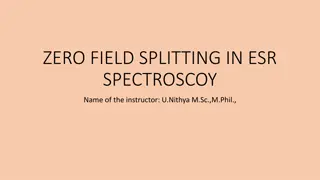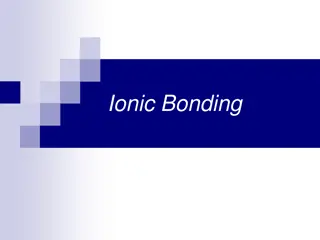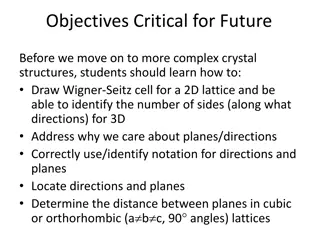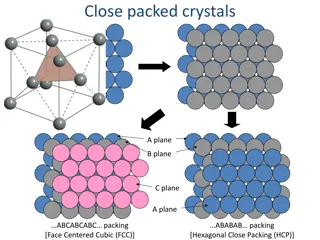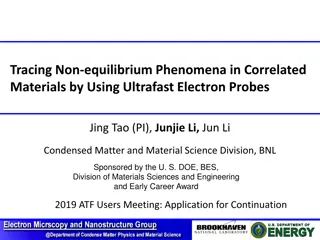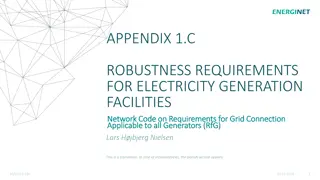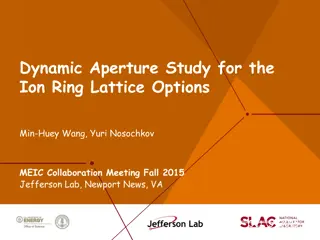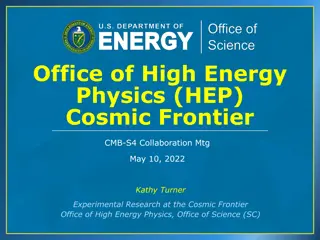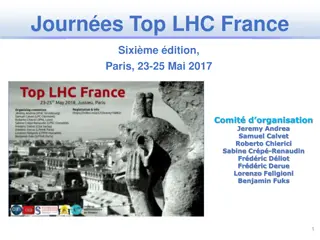Lattice Research Needs for Next-Generation HEP Facilities
Lattice research is vital for determining the characteristics of accelerators, colliders, and storage rings. High beam brightness is crucial for achieving goals like luminosity and beam loss reduction. The main barriers to higher beam brightness include instabilities and particle loss. General requirements for next-generation lattices focus on high betatron tune, effective chromaticity control, and single particle stability. Means of achieving these goals include superperiodicity and optics integrability.
Download Presentation

Please find below an Image/Link to download the presentation.
The content on the website is provided AS IS for your information and personal use only. It may not be sold, licensed, or shared on other websites without obtaining consent from the author.If you encounter any issues during the download, it is possible that the publisher has removed the file from their server.
You are allowed to download the files provided on this website for personal or commercial use, subject to the condition that they are used lawfully. All files are the property of their respective owners.
The content on the website is provided AS IS for your information and personal use only. It may not be sold, licensed, or shared on other websites without obtaining consent from the author.
E N D
Presentation Transcript
GARD ABP Workshop 1 (WG1): Lattice research needs of next- generation HEP facilities Valeri Lebedev December 9-10, 2019
Lattice Research Needs Lattice design determines all main characteristics of accelerator, collider or storage ring Present and future goals of beam physics Beam brightness increase (Grand Challenge #2) Luminosity, SR brightness, etc. Beam loss reduction (Grand Challenge #3) Reliability Serviceability Cost reduction Creates ways to higher energy, power, Reliability improvement (other than beam loss) Energy (wall-plug) efficiency improvement The past shows that new ideas are usually applicable to a wide range of accelerator types: e.g. strong focusing, 2 12/09/2019
Why do we want High Beam Brightness? Colliders Luminosity 1/ 2 High power proton (ion) synchrotrons Small beam cross-section Reduces the cost Allows to focus the beam to small size on the target An increase of beam brightness may be the only choice for power increase if machine is already built SR sources Increase the SR brightness High brightness implies small transverse emittances However very small momentum spread typically is not required 3 12/09/2019
Main Barriers to Higher Beam Brightness Instabilities A limitation at all high-intensity machines Particle loss due to non-linearity of single particle motion, excited by beam space charge Important at low and medium energy high intensity accelerators beam-beam effects in colliders Intrabeam scattering Important for colliders and storage rings Multiple IBS drives emittance growth Single IBS (Touschek) creates beam loss and non-gaussian tails 4 12/09/2019
General Requirements to the Next Generation Lattices Goals High betatron tune (IBS, instabilities, high transition energy) Effective chromaticity control at high betatron tunes Single particle stability (resonances), instabilities Colliders: chromatic compensation of IR Large dynamic aperture Means of achieving these goals Superperiodicity Optics integrability Lattices with strong x-y coupling by design Space charge tune shift, IBS Superior optics measurement and correction 5 12/09/2019
Superperiodicity: Effective Means for Space Charge Mitigation The tune shift due to beam-beam or space charge is typically limited to the total betatron tune shift for the entire ring It should be counted per 1 period for superperiodic machines Empirically, we know that superperiodicity helps (J-PARC) Superperiodicity creates a possibility to increase greatly the beam brightness/intensity It is easier to achieve in a Rapid Cycling Synchrotron where beam stays at high tune shifts only for few thousand turns and only low order non-linearities play significant role Modern instrumentation allows us to measure -functions to ~1% accuracy We need to achieve better understanding to what accuracy we need to build and tune machine optics to get the expected gain in beam brightness 6 12/09/2019
Optics Integrability Main advantage: Creates a path to increase dynamic aperture Challenges with present proposals Quite complicated beam optics High sensitivity to focusing errors Some integrable optics concepts are more sensitive than others Complications with chromaticity control High sensitivity to the beam space charge New ideas are needed 7 12/09/2019
Lattices with High Betatron Tune High betatron tune (i.e. small beta-functions) advantages Reduces IBS Reduces SR heating in electron storage rings/colliders Reduces growth rates of transverse instabilities Allows to reduce the vacuum chamber aperture and, consequently, the machine cost What limits high betatron tune Reduction of dispersion function. Requires higher sextupole fields for chromaticity compensation limitation of dynamic aperture We need to find how we could introduce suppression of chromaticity without compromising the dynamic aperture This may be part of research into optics integrability 8 12/09/2019
A couple of words about IBS Above transition Mitigation of longitudinal IBS Lifetime growth proportionally to the momentum spread increase It is the only effective means Mitigation of transverse IBS Decrease of D2/ requires high horizontal tune Lattices with high betatron tune are required for the IBS mitigation Below transition Quasi-equilibrium ( x~ y~ s) may greatly reduce IBS Small beta-beating High horizontal tune to increase transition energy (if required) 2 1 d dt p p dN ds 2 x y s 2 2 d D d dt p p x x 2 dt x local s 9 12/09/2019
Where are we today? Great progress in optics measurements and control / 5-10%: Tevatron, LHC, / 1%: SR sources (electron rings) Tevatron optics model included x-y coupling, which could not be fully compensated with existing skew-quads FNAL high-energy cooler had strong x-y coupling by design Optics was fully measured and corrected Superperiodicity tests JPARC, PS Booster Our proposal for EIC ring-based electron cooling has 100% x-y coupling by design Integrable optics studies are carried out in IOTA (Fermilab) 10 12/09/2019
Synergies This topic is quite universal. There are many potential synergies in this area with future BES and NP facilities. 11 12/09/2019
Timeline / Milestones IOTA and UMER are built and represent good playgrounds for experimental studies for coming years IOTA has larger energy and supports studies both with proton and electron beams Benchmarking of existing codes with experimental studies Construction of small superperiodic ring with the goal to achieve the space charge tune shifts more than 1. 12 12/09/2019
Conclusions The work on lattice research address all Grand Challenges of GARD ABP mission presented in the workshop template Major directions for future developments in beam optics Superperiodic lattices Integrable optics Chromaticity control in lattices with high betatron tunes Optics measurements and control Major fraction of experimental studies may be carried out at many existing machines While IOTA and UMER are the only machines built for such studies 13 12/09/2019






